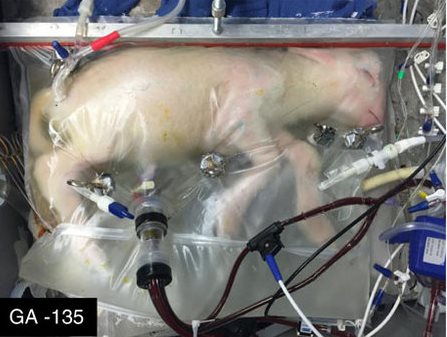Claire Horn is in the first year of her PhD in Birkbeck’s School of Law. She is researching the legal and ethical implications of artificial wombs.

Credit: Partridge et al. Nature Communications
A few weeks ago, a team of scientists published their research on “An extra-uterine system to physiologically support the extreme premature lamb” in the journal Nature Communications. Within a few days of being posted online, the study had received enthusiastic coverage from major international news outlets and popular think-piece platforms alike. In the media, the language around the research changed: the “extra-uterine system” was redubbed “the artificial womb.”
Currently fetal viability in humans (the time at which a foetus can survive outside the mother) happens around 28 weeks. As the original article states, recent developments have pushed this timeline back to 22-23 weeks, but not without continued complications for the baby. The Biobag, designed to mimic the womb, has allowed a lamb foetus inserted at the developmental equivalent of 23 human weeks to survive and grow to healthy viability.
While, as the scientists who conducted this research state plainly, this technology is still a long way from being trialed with humans, and while the Biobag is only a partial artificial womb (an artificial womb proper would entail the foetus growing outside the body for the duration of gestation), the popular presses which picked up this news focus on questions emerging from the presumption that an artificial womb is inevitable. Their queries range from what an artificial womb might mean for how we conceive of personhood, to discussions of the ethics of research on foetuses, to debates over what impact such technology might have on the infants who are born through it.
In one way, these are very old debates that have echoed throughout science—and science fiction—for centuries. But the artificial womb has never felt closer than it does today, and while it is the work of scientists to proceed with caution, scepticism, and the suspicion that what aids a lamb may not aid a human, it is the work of legal scholars and bioethicists to imagine the possibilities, dangers, and issues inherent if this technology does in fact arrive.
My PhD research begins with these premises: that the artificial womb is on its way, that the law is rarely prepared to meet the challenges of new reproductive technologies, and that we should consider the different frameworks available to us ahead of the artificial womb’s arrival. Thinking about the ethics of the artificial womb allows us to consider new ways in which we might approach reproduction, familial relationships, and gender in the future. AAs the primary tool that structures the rules of engagement in our societies, legal frameworks can be introduced or renegotiated in ways that could make space for new social developments.
The artificial womb is an opportunity for legal scholars to consider important questions in this regard. With the artificial womb—which could constitute the growth of a foetus separately from the mother even at the earliest stage of development—might we be able to beneficially renegotiate abortion law to protect womens’ bodily autonomy? Could the artificial womb prompt us to reframe legal doctrines of parenthood in ways that offer greater protection to trans and queer parents, and greater equality in co-parenting? Could it render gender entirely irrelevant to parenting roles?
A central consideration in my work, and one that I have found absent in many media discussions of the artificial womb is the ways in which reproductive technologies have historically been used to benefit some communities while subjugating others. As Deborah Wilson Lowry writes, “new technologies, when not accompanied by equal access or distribution, can increase existing disparities related to race, class, and gender”. Such inequalities have been starkly demonstrated with regard to the introduction of the pill (which, prior to being marketed as the key to sexual liberation was tested on poor women and women of color, often without their consent), and with regard to surrogacy (only available to those with financial and social means, often outsourced to poor women in the global South), to name just a few examples.
Like these technologies before it, the artificial womb is unlikely to have either purely utopian or purely dystopian results, and it is necessary to be attentive to the dangers it might present for those who have been made vulnerable by these technologies in the past. Research by legal scholars and bioethicists which places marginalized people at the forefront, work which is lead by and consults with diverse groups of women, including women of color, trans women, and women with disabilities, is necessary in advance of the artificial womb’s introduction.
Scientists may be rightly skeptical of the speed at which humanities scholars have rushed from the growth of a premature lamb in a Biobag to heralding the growth of human babies outside the body. But proceeding with this future in mind, and carefully considering the ethical dilemmas that it presents, will allow us to interrogate its dangers and consider the best possible legal frameworks and policies to protect women when it arrives.

Indeed it’s a big rush believing full ectogenesis is even in the near-future. I’ll be really surprised if that happens in the next decades.
This device is a life saving method for preterm babies and it’s probably not going to be much else for decades to come